Variable Weight Matter–Element Extension Model for the Stability Classification of Slope Rock Mass
Abstract
:1. Introduction
2. Basic Principles of the Matter–Element Extension Model
2.1. Matter Elements, Classical Domains, and Nodal Domains
2.2. Extension Correlation Functions
2.3. Level Variable Method
3. Extreme Entropy Weighting and Variable Weighting Theory
3.1. Principle of Extreme Entropy Weighting
- The eigenvalue xij of the evaluation object Xi is obtained by extremum method and transformed into a dimensionless value vij. If the feature xij of the evaluation object xi belongs to the positive type, it is processed by Equation (9). If the feature xij of the evaluation object xi belongs to the reverse type, it is processed by Equation (10) [27]:where xij is the eigenvalue of Xi, Mj is the maximum value of xij; mj is the minimum value of xij; vij is the dimensionless value of xij, i = 1, 2,…, n; j = 1, 2,…, m.
- The dimensionless vij of the evaluation object Xi is normalized:where vij is the dimensionless value of the feature xij; rij is the normalized value of the feature xij; and n is the total number of objects to be evaluated.
- The feature information entropy of evaluation object Xi is calculated as follows:where ej is the feature information entropy of the object Xi to be evaluated; rij is the normalized value of the feature xij, i = 1, 2,…, n; j = 1, 2,…, m; and ej ∈ [0,1].
- The feature weight of evaluation object Xi is calculated as follows:where w0j is the weight of the feature xij; ej is the feature information entropy of the feature xij; and m is the total number of features to be evaluated.
3.2. Basic Theory of Variable Weight
4. Establishment of Variable Weight Matter–Element Extension Model for Slope Rock Mass Stability Classification
5. Case Study in a Mining Project
6. Conclusions
- (1)
- The evaluation index dimension was unified using the extremum method, and the objective constant weight of the evaluation index (namely, uniaxial compressive strength; elastic modulus; Poisson’s ratio; structural features; cohesion force; internal friction; and daily maximum rainfall) was calculated using the entropy weight method. The constant weight reflects the relative importance of the evaluation indexes. On this basis, the variable weight theory was introduced to fully consider the influence of the value difference of the classification evaluation index on the index weight, and the excitation feature variable weight function was used to calculate the weighting of the evaluation index of each rock mass, so that the weighting of the evaluation index was more reasonable.
- (2)
- By applying the matter–element extension model and grade-variable method, the variable interval corresponding to the evaluation index standard of the stability grade of the slope rock mass and the variable value of the stability grade of each rock mass were calculated, and the stability grade of each rock mass was obtained. The evaluation results presented in this study are consistent with the engineering practice and are more accurate than those of the hierarchical extension model and the multi-level unascertained measure-set pair analysis model.
- (3)
- The variable value of the slope rock mass stability grade was obtained by the integrated information of comprehensive correlation between the evaluation index value of the slope rock mass stability and each stability grade. The accuracy of the extension model, in the classification of the slope rock mass stability, can be improved by the classification of the slope rock mass stability through the interval of the variable values of the grades corresponding to the evaluation index standard and the variable values for each slope rock mass stability grade.
Author Contributions
Funding
Institutional Review Board Statement
Informed Consent Statement
Data Availability Statement
Acknowledgments
Conflicts of Interest
References
- Wang, S.H.; Li, X.H.; Yao, J.R.; Gong, F.Q.; Li, X.; Du, K.; Tao, M.; Huang, L.Q.; Du, S.L. Experimental investigation of rock breakage by a conical pick and its application to non-explosive mechanized mining in deep hard rock. Int. J. Rock Mech. Min. Sci. 2019, 122, 104063. [Google Scholar] [CrossRef]
- Wang, S.F.; Sun, L.C.; Li, X.B.; Wang, S.Y.; Du, K.; Li, X.; Feng, F. Experimental investigation of cuttability improvement for hard rock fragmentation using conical cutter. Int. J. Geomech. 2021, 21, 06020039. [Google Scholar] [CrossRef]
- Yang, T.H.; Zhang, F.C.; Yu, Q.L.; Cai, M.F.; Li, H.Z. Research situation of open-pit mining high and steep slope stability and its developing trend. Rock Soil Mech. 2011, 32, 1437–1452. [Google Scholar]
- Wang, S.F.; Tang, Y.; Li, X.B.; Du, K. Analyses and predictions of rock cuttabilities under different confining stresses and rock properties based on rock indentation tests by conical pick. Trans. Nonferrous Met. Soc. China 2021, 31, 1766–1783. [Google Scholar] [CrossRef]
- Wang, S.F.; Tang, Y.; Wang, S.Y. Influence of brittleness and confining stress on rock cuttability based on rock indentation tests. J. Cent. South Univ. 2021, 28, 2786–2800. [Google Scholar] [CrossRef]
- Shi, W.H.; Yang, T.H.; Wang, P.T.; Hu, G.J.; Xiao, P. Anisotropy analysis method for stability of open-pit slope rock mass and its application. Chin. J. Geotech. Eng. 2014, 36, 1924–1933. [Google Scholar]
- Zhao, H.J.; Ma, F.S.; Guo, J.; Wu, Z.Q.; Zhang, Y.L. The influence of open pit to underground mining on the stability of slope rock mass. J. Coal Mine 2011, 36, 1635–1641. [Google Scholar]
- Du, S.G.; Yong, R.; Chen, J.Q.; Chen, J.Q.; Xia, C.C.; Li, G.P.; Liu, W.L.; Liu, Y.M.; Liu, H. Graded analysis for slope stability assessment of large open-pit mines. Chin. J. Rock Mech. Eng. 2017, 36, 2601–2611. [Google Scholar]
- Bar, N.; Kostadinovski, M.; Tucker, M.; Byng, G.; Rachmatullah, R.; Maldonado, A.; Pötsch, M.; Gaich, A.; McQuillan, A.; Yacoub, T. Rapid and robust slope failure appraisal using aerial photogrammetry and 3D slope stability models. Int. J. Min. Sci. Technol. 2020, 30, 651–658. [Google Scholar] [CrossRef]
- Arikan, F.; Yoleri, F.; Sezer, S.; Caglan, D.; Biliyul, B. Geotechnical assessments of the stability of slopes at the Cakmakkaya and Damar open pit mines (Turkey): A case study. Environ. Earth Sci. 2010, 61, 741–755. [Google Scholar] [CrossRef]
- Wang, X.; Kang, Q.; Qin, J.; Zhang, Q.; Wang, S. Application of AHP-extenics model to safety evaluation of rock slope stability. J. Cent. South Univ. Sci. Technol. 2013, 44, 2455–2462. [Google Scholar]
- Zhang, X.; Zhou, S.W.; Lin, P.; Tan, Z.; Chen, Z.; Jiang, S. Slope stability evaluation based on entropy coefficient-set pair analysis. Chin. J. Rock Mech. Eng. 2018, 37, 3400–3410. [Google Scholar]
- Huang, D.; Shi, X.Z.; Qiu, X.Y.; Gou, Y. Stability gradation of rock slopes based on multilevel uncertainty measure-set pair analysis theory. J. Cent. South Univ. Sci. Technol. 2017, 48, 1057–1064. [Google Scholar]
- Liu, L.L.; Zhang, S.H.; Liu, L.M. Model and application of AHP and ideal point method based on stability gradation of rock slope. Chin. J. Cent. South Univ. Sci. Technol. 2014, 10, 3499–3504. [Google Scholar]
- Bar, N.; Barton, N. The Q-slope method for rock slope engineering. Rock Mech. Rock Eng. 2017, 50, 3307–3322. [Google Scholar] [CrossRef]
- Pastor, J.L.; Riquelme, A.J.; Tomás, R.; Cano, M. Clarification of the slope mass rating parameters assisted by SMRTool, an open-source software. Bull. Eng. Geol. Environ. 2019, 78, 6131–6142. [Google Scholar] [CrossRef] [Green Version]
- Cai, W. Introduction of Extenics. Syst. Eng. Theory Pract. 1998, 18, 76–84. [Google Scholar]
- Cai, W. Extension theory and its application. Chin. Sci. Bull. 1999, 44, 673–682. [Google Scholar] [CrossRef]
- Xu, H.J.; Zhao, B.F.; Zhou, Y.; Liu, S.X. Evaluation on water disaster from roof strata based on the entropy-weight and matter-element extension model. J. Min. Saf. Eng. 2018, 35, 112–117. [Google Scholar]
- Cai, W.; Yang, C.Y. Basic theory and methodology on extenics. Chin. Sci. Bull. 2013, 58, 1190–1199. [Google Scholar]
- Yang, C.Y.; Cai, W. Recent research progress in dependent functions in extension sets. J. Guangdong Univ. Technol. 2012, 29, 7–14. [Google Scholar]
- Shi, Z.P.; Shan, T.H.; Liu, W.F.; Zhang, X.P. Comprehensive evaluation of power network operation risk based on matter-element extensible model. Power Syst. Technol. 2015, 39, 3233–3239. [Google Scholar]
- Chen, S.Y. Theory and Model of Variable Fuzzy Sets and Its Application; Dalian University of Technology Press: Dalian, China, 2009. [Google Scholar]
- Li, Z.Y.; Rong, W.Y.; Chen, Z.D. Evaluation of railway luggage and parcel transportation safety based on variable fuzzy sets theory. China Saf. Sci. J. 2018, 28, 186–190. [Google Scholar]
- Hu, B.Q.; Zhang, X. Improvement and application of extension evaluation method. J. Wuhan Univ. 2003, 36, 79–84. [Google Scholar]
- Zhu, X.A.; Wei, G.D. Discussion on the good standard of dimensionless method in entropy method. Stat. Decis. 2015, 31, 12–15. [Google Scholar]
- Wang, W.; Luo, Z.Q.; Xiong, L.X.; Jia, N. Research of goaf stability evaluation based on improved matter-element extension model. J. Saf. Environ. 2015, 15, 21–25. [Google Scholar] [CrossRef]
- Tang, X.W.; Zhou, Z.F.; Shi, Y. The variable weighted functions of combined forecasting. Comput. Math. Appl. 2003, 45, 723–730. [Google Scholar] [CrossRef] [Green Version]
- Wang, P.Z.; Li, H.X. Fuzzy System Theory and Fuzzy Computer; Science Publishing Company of Beijing: Beijing, China, 1996. [Google Scholar]
- Li, D.Q.; Li, H.X. The properties and construction of state variable weight vectors. J. Beijing Norm. Univ. Nat. Sci. 2002, 38, 455–461. [Google Scholar]
- Atanassov, K.T. Operators over interval-valued intuitionistic fuzzy sets. Fuzzy Sets Syst. 1994, 64, 159–174. [Google Scholar] [CrossRef]
- Li, H.X. Factor spaces and mathematical frame of knowledge represention (VIII). Fuzzy Syst. Math. 1995, 9, 1–9. [Google Scholar]
- GB/T 50218-2014, Engineering Rock Mass Classification Standard. Available online: https://www.chinesestandard.net/PDF/BOOK.aspx/GBT50218-2014 (accessed on 10 August 2021).
- GB/T 50218-1994, Engineering Rock Mass Classification Standard. Available online: https://www.chinesestandard.net/PDF/BOOK.aspx/GB50218-1994 (accessed on 10 August 2021).
- GB 50487-2008, Code for Engineering Geological Investigation of Water Resources and Hydropower. Available online: https://www.chinesestandard.net/PDF/BOOK.aspx/GB50487-2008 (accessed on 10 August 2021).
- Kang, Z.Q.; Zhou, H.; Feng, X.T.; Yang, C.X. Evaluation of high rock slope quality based on theory of extenics. J. Northeast. Univ. Nat. Sci. 2007, 28, 1770–1774. [Google Scholar]
- Mo, G.L.; Zhang, W.G.; Liu, Y.J. Construction of Variable Spatial Weight and Analysis of Spatial Effect. J. Syst. Manag. 2018, 27, 219–229. [Google Scholar]
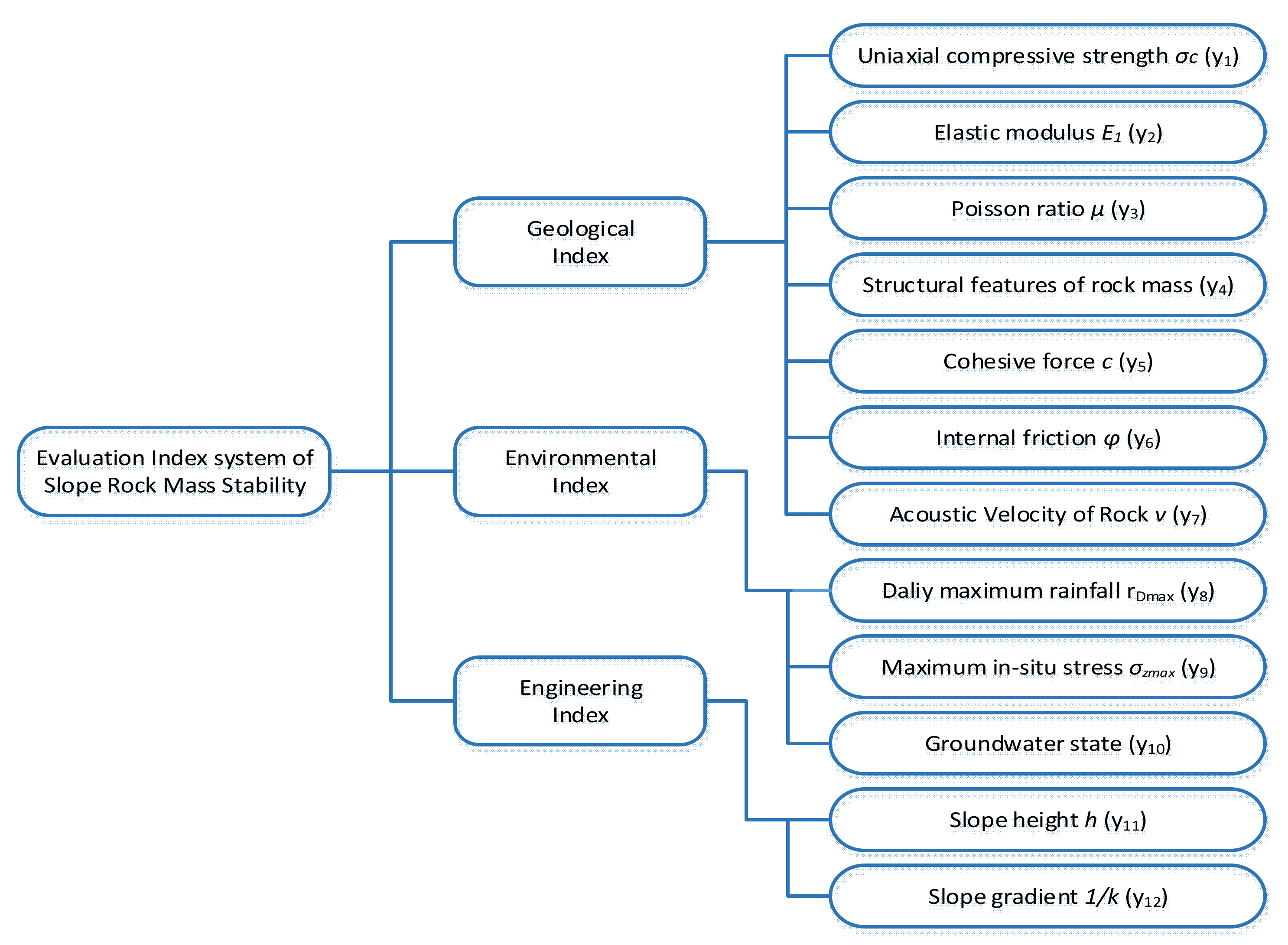
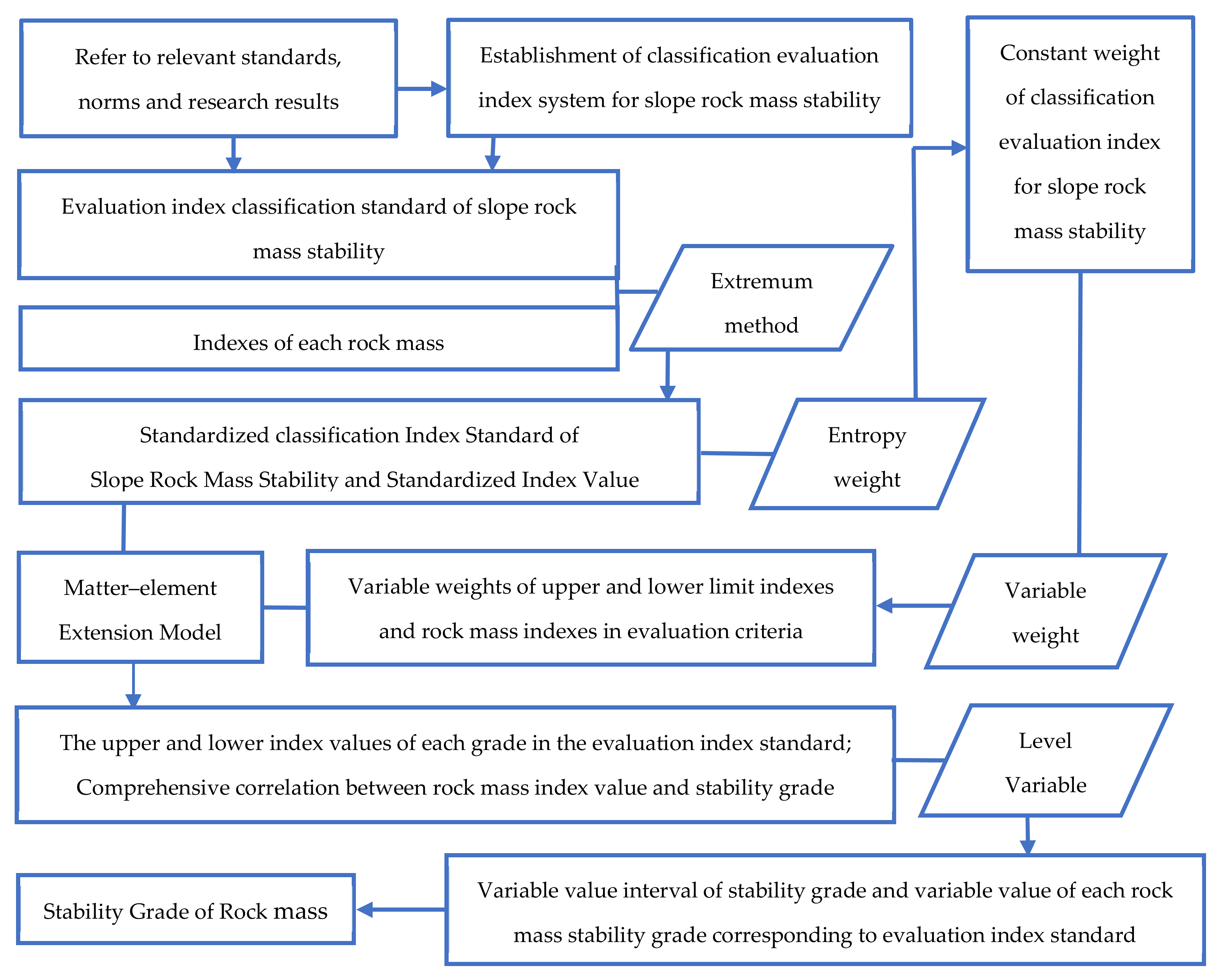
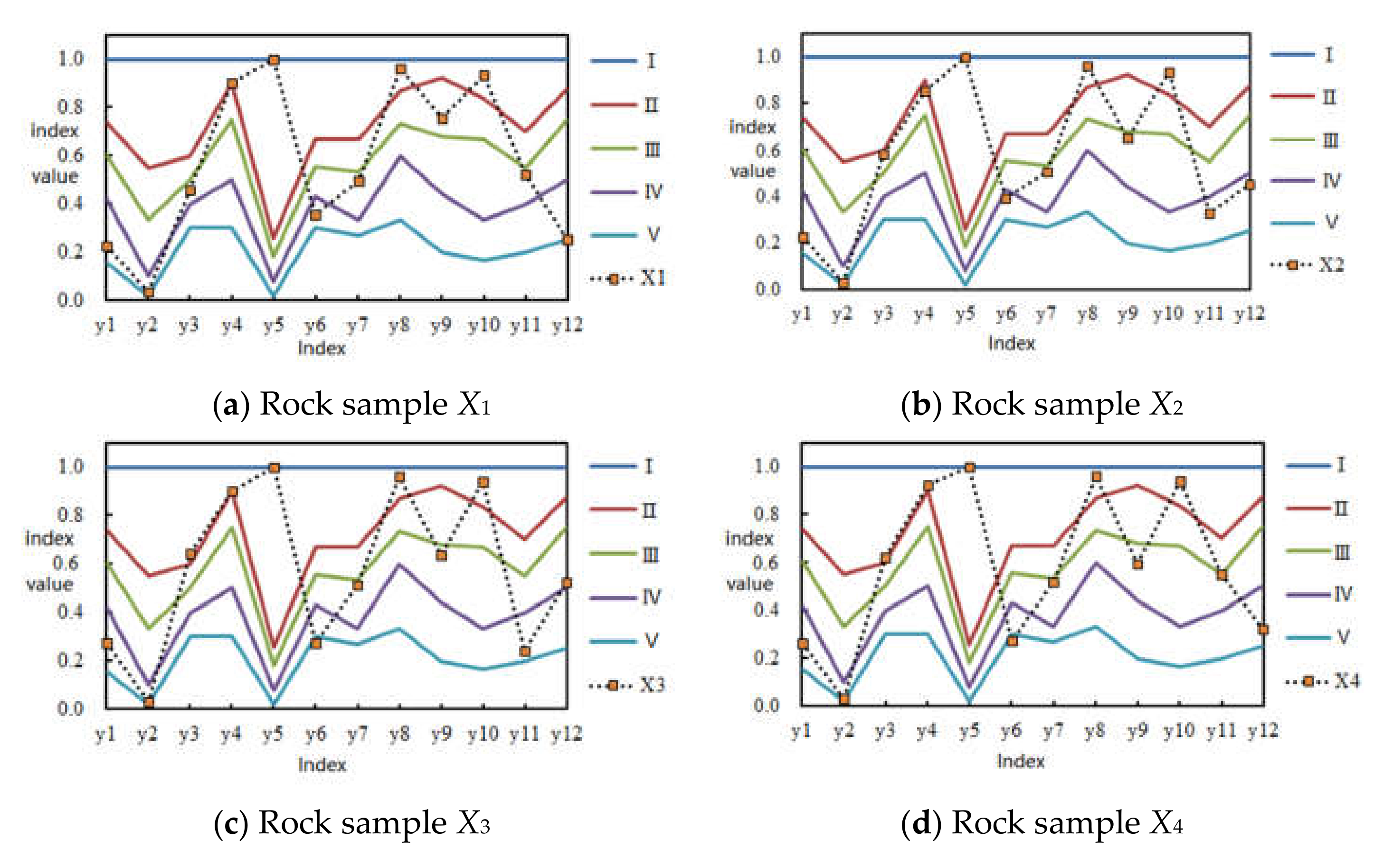
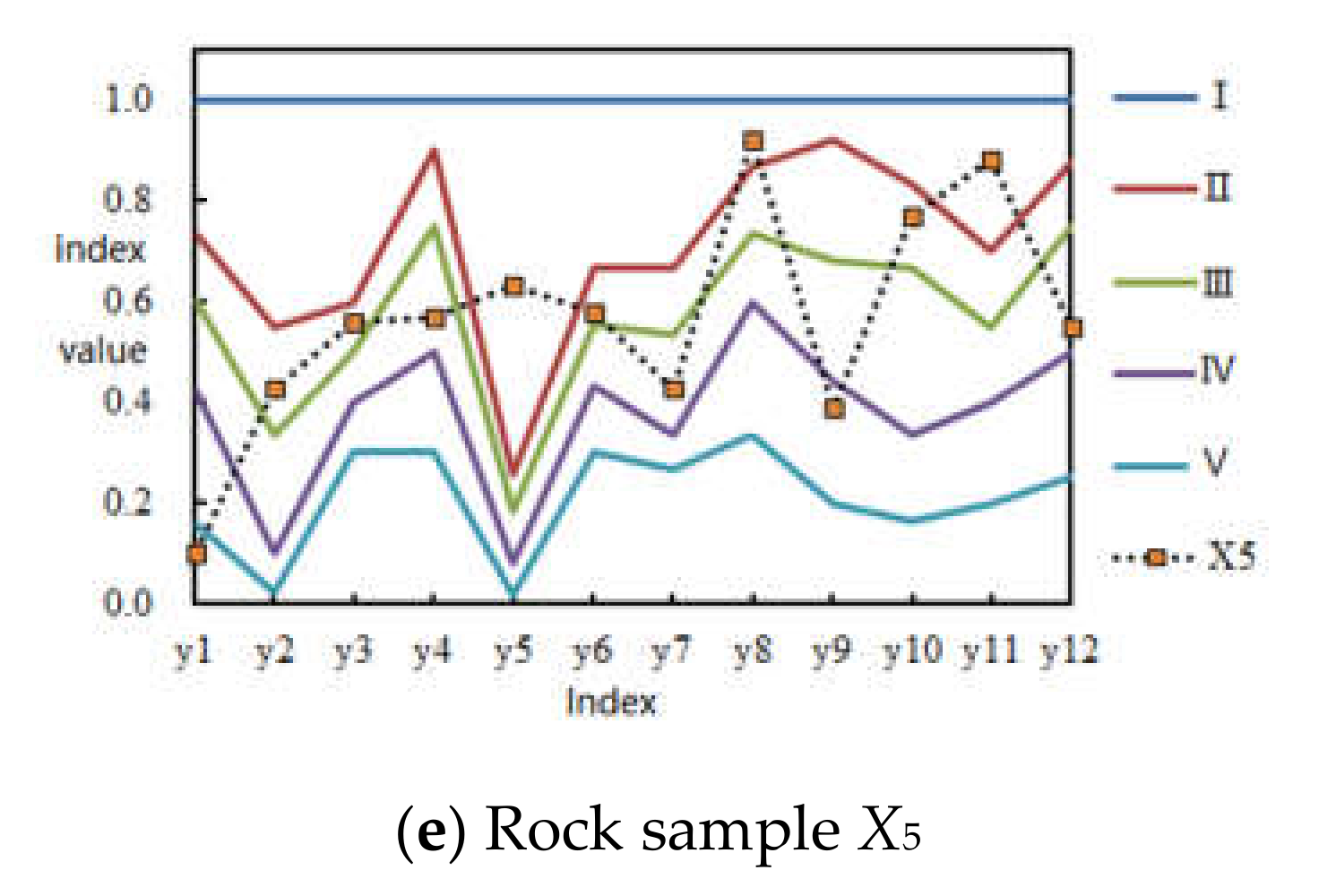
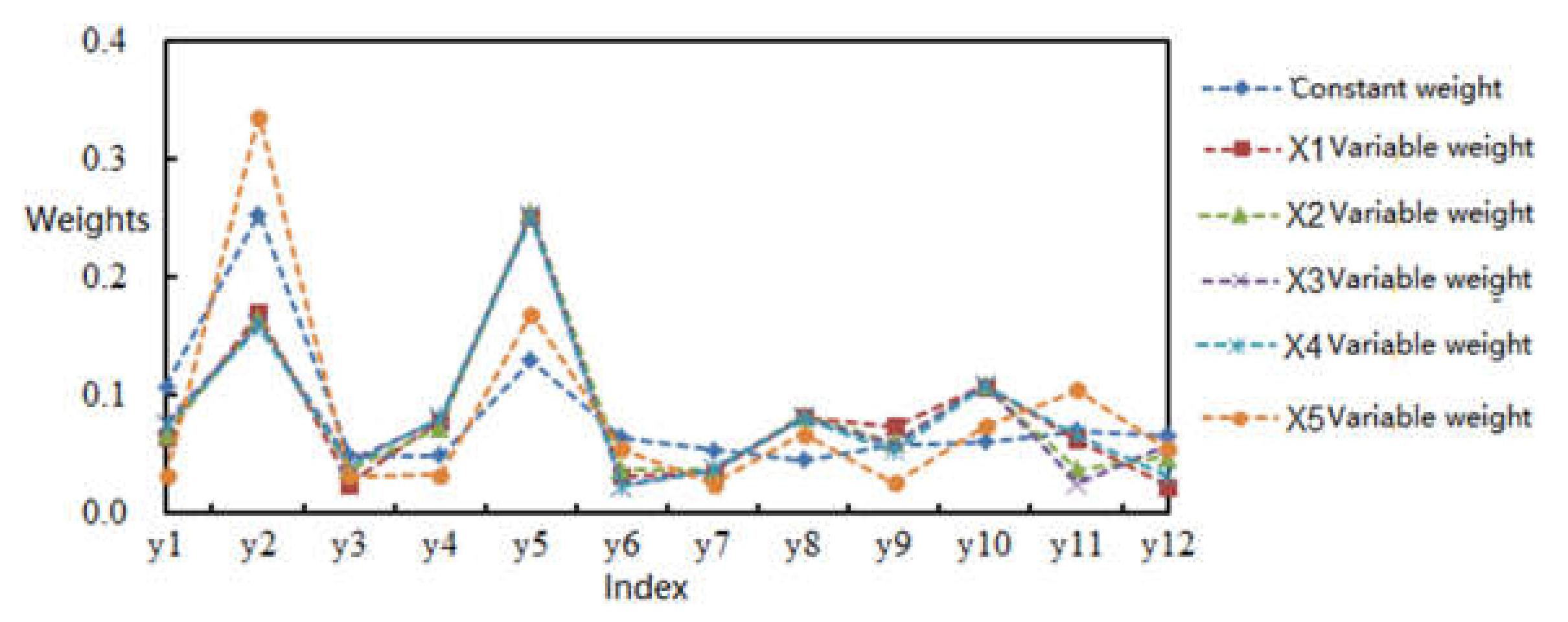
| Grade | y1/MPa | y2/GPa | y3 | y4/% | c y5/MPa | y6/(°) |
| Level I (extremely stable) | [150,200] | [33.0,60.0] | [0,0.20] | [90,100] | [2.10,8.00] | [60,90] |
| Level II (stable) | [125,150) | [20.0,33.0) | [0.20,0.25) | [75,90) | [1.50,2.10) | [50,60) |
| Level III (basically stable) | [90,125) | [6.0,20.0) | [0.25,0.30) | [50,75) | [0.70,1.50) | [39,50) |
| Level IV (unstable) | [40,90) | [1.3,6.0) | [0.30,0.35) | [30,50) | [0.20,0.70) | [27,39) |
| Level V (extremely unstable) | [10,40) | [0,1.3) | [0.35,0.50) | [0,30) | [0.05,0.20) | [0,27) |
| Grade | v y7/km·s−1 | y8/mm | y9/MPa | y10/L∙(min.10m)−1 | h y11/m | 1/k y12/(°) |
| Level I (extremely stable) | [5.0,7.5] | [0,20] | [0,2] | [0,25] | [0,30] | [0,10] |
| Level II (stable) | [4.0,5.0) | (20,40] | (2,8] | (25,50] | (30,45] | (10,20] |
| Level III (basically stable) | [2.5,4.0) | (40,60] | (8,14] | (50,100] | (45,60] | (20,40] |
| Level IV (unstable) | [2.0,2.5) | (60,100] | (14,20] | (100,125] | (60,80] | (40,60] |
| Level V (extremely unstable) | [0,2.0) | (100,150] | (20,25] | (125,150] | (80,100] | (60,80] |
| Rock | Measured Values of Geological Indexes | ||||||
y1/MPa | y2/GPa | y3 | y4/% | c y5/MPa | y6/° | v y7/km·s−1 | |
| X1 | 52.60 | 2.3 | 0.27 | 90 | 17.80 | 31.8 | 3.700 |
| X2 | 53.00 | 2.0 | 0.21 | 85 | 17.80 | 35.6 | 3.789 |
| X3 | 61.60 | 1.9 | 0.18 | 90 | 23.10 | 24.6 | 3.847 |
| X4 | 60.04 | 1.9 | 0.19 | 92 | 23.10 | 24.6 | 3.896 |
| X5 | 28.97 | 25.7 | 0.22 | 57 | 5.08 | 52.0 | 3.200 |
| Rock | Measured Values of Environmental Indexes | Measured Values of Engineering Indexes | |||||
y8/mm | y9/MPa | y10/L∙(min·10 m)−1 | h y11/m | 1/k y12/° | |||
| X1 | 6.06 | 6.18 | 10 | 48 | 60 | ||
| X2 | 6.06 | 8.73 | 10 | 67 | 44 | ||
| X3 | 6.06 | 9.05 | 9 | 76 | 38 | ||
| X4 | 6.06 | 10.18 | 9.5 | 45 | 54 | ||
| X5 | 12.00 | 15.32 | 35 | 12 | 36 | ||
| Rock Sample | y1 | y2 | y3 | y4 | y5 | y6 | y7 | y8 | y9 | y10 | y11 | y12 |
|---|---|---|---|---|---|---|---|---|---|---|---|---|
| X1 | 0.22 | 0.04 | 0.46 | 0.90 | 1.00 | 0.35 | 0.49 | 0.96 | 0.75 | 0.93 | 0.52 | 0.25 |
| X2 | 0.23 | 0.03 | 0.58 | 0.85 | 1.00 | 0.40 | 0.51 | 0.96 | 0.65 | 0.93 | 0.33 | 0.45 |
| X3 | 0.27 | 0.03 | 0.64 | 0.90 | 1.00 | 0.27 | 0.51 | 0.96 | 0.64 | 0.94 | 0.24 | 0.53 |
| X4 | 0.26 | 0.03 | 0.62 | 0.92 | 1.00 | 0.27 | 0.52 | 0.96 | 0.59 | 0.94 | 0.55 | 0.33 |
| X5 | 0.10 | 0.43 | 0.56 | 0.57 | 0.63 | 0.58 | 0.43 | 0.92 | 0.39 | 0.77 | 0.88 | 0.55 |
| Index | y1 | y2 | y3 | y4 | y5 | y6 | y7 | y8 | y9 | y10 | y11 | y12 | |
|---|---|---|---|---|---|---|---|---|---|---|---|---|---|
| Constant weight | 0.107 | 0.254 | 0.048 | 0.048 | 0.129 | 0.063 | 0.053 | 0.045 | 0.057 | 0.060 | 0.070 | 0.066 | |
| Weighted variable | X1 | 0.065 | 0.169 | 0.025 | 0.078 | 0.252 | 0.031 | 0.034 | 0.081 | 0.074 | 0.107 | 0.062 | 0.022 |
| X2 | 0.066 | 0.164 | 0.037 | 0.072 | 0.255 | 0.037 | 0.036 | 0.082 | 0.060 | 0.108 | 0.036 | 0.047 | |
| X3 | 0.076 | 0.160 | 0.044 | 0.079 | 0.253 | 0.022 | 0.036 | 0.081 | 0.058 | 0.109 | 0.025 | 0.057 | |
| X4 | 0.073 | 0.158 | 0.041 | 0.081 | 0.251 | 0.022 | 0.037 | 0.080 | 0.052 | 0.107 | 0.066 | 0.031 | |
| X5 | 0.031 | 0.336 | 0.031 | 0.032 | 0.168 | 0.054 | 0.024 | 0.067 | 0.025 | 0.073 | 0.104 | 0.054 | |
| Index | Single Index Correlation | |||||||||||
|---|---|---|---|---|---|---|---|---|---|---|---|---|
| y1 | y2 | y3 | y4 | y5 | y6 | y7 | y8 | y9 | y10 | y11 | y12 | |
| I | −0.696 | −0.931 | −0.233 | 0.000 | 1.000 | −0.470 | −0.260 | 1.040 | −0.403 | 1.067 | −0.273 | −0.714 |
| II | −0.630 | −0.886 | −0.080 | 0.000 | 0.000 | −0.364 | −0.075 | −0.699 | 0.420 | −0.599 | −0.059 | −0.667 |
| III | −0.468 | −0.620 | 0.095 | −0.600 | 0.000 | −0.185 | 0.088 | −0.850 | −0.228 | −0.799 | 0.067 | −0.500 |
| IV | 0.418 | 0.810 | −0.115 | −0.800 | 0.000 | 0.177 | −0.245 | −0.900 | −0.559 | −0.900 | −0.200 | 0.000 |
| V | −0.228 | −0.309 | −0.258 | −0.857 | 0.000 | −0.131 | −0.315 | −0.940 | −0.691 | −0.920 | −0.400 | 0.000 |
| Grade | I | II | III | IV | V |
|---|---|---|---|---|---|
| Level Variable k | [1.00, 1.86) | [1.86, 2.43) | [2.43, 3.58) | [3.58, 4.27) | [4.27, 5] |
| Sample | Comprehensive Correlation | Level Variable k | The Proposed Model | Hierarchical-Extension Model [5] | Multi-Level Unascertained Measure-Set Pair Analysis Model [7] | Actual Situation | ||||
|---|---|---|---|---|---|---|---|---|---|---|
| S(1) | S(2) | S(3) | S(4) | S(5) | ||||||
| X1 | 0.155 | −0.315 | −0.361 | −0.127 | −0.405 | 2.04 | Level II | Level II | Level III | Level II |
| X2 | 0.144 | −0.323 | −0.337 | −0.123 | −0.384 | 2.05 | Level II | Level I | Level II (near Level III) | Level II |
| X3 | 0.172 | −0.368 | −0.359 | −0.155 | −0.392 | 1.93 | Level II (near Level I) | Level II | Level III | Level II |
| X4 | 0.201 | −0.364 | −0.359 | −0.165 | −0.394 | 1.88 | Level II (near Level I) | Level I | Level II | Level II |
| X5 | 0.289 | −0.111 | −0.312 | −0.475 | −0.508 | 1.62 | Level I | Level I | Level II | Level I |
Publisher’s Note: MDPI stays neutral with regard to jurisdictional claims in published maps and institutional affiliations. |
© 2021 by the authors. Licensee MDPI, Basel, Switzerland. This article is an open access article distributed under the terms and conditions of the Creative Commons Attribution (CC BY) license (https://creativecommons.org/licenses/by/4.0/).
Share and Cite
Yang, S.; Xu, Z.; Su, K. Variable Weight Matter–Element Extension Model for the Stability Classification of Slope Rock Mass. Mathematics 2021, 9, 2807. https://doi.org/10.3390/math9212807
Yang S, Xu Z, Su K. Variable Weight Matter–Element Extension Model for the Stability Classification of Slope Rock Mass. Mathematics. 2021; 9(21):2807. https://doi.org/10.3390/math9212807
Chicago/Turabian StyleYang, Shan, Zitong Xu, and Kaijun Su. 2021. "Variable Weight Matter–Element Extension Model for the Stability Classification of Slope Rock Mass" Mathematics 9, no. 21: 2807. https://doi.org/10.3390/math9212807
APA StyleYang, S., Xu, Z., & Su, K. (2021). Variable Weight Matter–Element Extension Model for the Stability Classification of Slope Rock Mass. Mathematics, 9(21), 2807. https://doi.org/10.3390/math9212807






